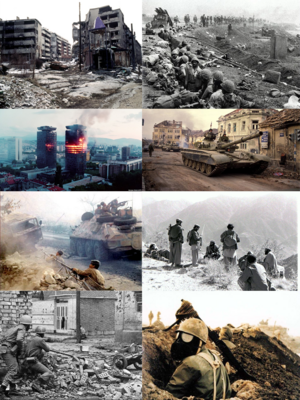Hisari Wars
This article is incomplete because it is pending further input from participants, or it is a work-in-progress by one author. Please comment on this article's talk page to share your input, comments and questions. Note: To contribute to this article, you may need to seek help from the author(s) of this page. |
| Hisari Wars | |||||||
|---|---|---|---|---|---|---|---|
 Clockwise from the top: Description | |||||||
| |||||||
| Belligerents | |||||||
|
Haydari Mujahideen (1976-81) Ramazani Mujahideen (1976-81) Shurawi Mujahideen (1976-81) |
(1973-78) Grand Duchy of Veliky Belgorod (1973-78) (1978-81) | ||||||
| Commanders and leaders | |||||||
|
Hisari Leaders |
Romellenic and Belgorodski Leaders
Simeon Kanizhanski Grand Knyaz of Veliky Belgorod | ||||||
| Strength | |||||||
|
Hisaristan At the onset of the warAfter Fahran declares war in 1978 1981 |
Romellenic Federation At the onset of the war1978 Fahran Fahran declares war in 19781981 | ||||||
| Casualties and losses | |||||||
|
Military dead 100,000-400,000 Military wounded 400,000-1,000,000 Military missing 75,000-100,000 Total 575,000-1,500,000 KIA, WIA or MIA |
Military dead 35,000-50,000 Military wounded 50,000-100,000 Military missing 25,000-75,000 Total 110,000-225,000 KIA, WIA, or MIA Military dead 200,000-400,000 Military wounded 200,000-1,200,000 Military missing 75,000-125,000 Total 475,000-1,725,000 KIA, WIA, or MIA | ||||||
Romellea vs. Hisaristan
1973: Emperor Khasar declares a series of decrees aimed at reforming the state, military, and economy. Among the decrees are the revocation of the sovereignty of the Empire's vassal states and their direct integration into Hisaristan. The Grand Duchy of Veliky Belgorod refuses to accept the decrees and declares independence from Hisaristan. Romelia recognizes Belgorod's independence and stations troops within Belgorod's borders. Khasar declares war on Belgorod and drags Romelia in. Upon the declaration of war, Romelia launches a swift campaign that conquers around half of the Russian-speaking regions that now constitute the Vilayet of Veliky Rus'.
1974: the Hisaris launch a counter-offensive the quickly drives the Romelleans out of Great Rus' and fight their way through the Grand Duchy of Belgorod. The Hisari army successfully repels a Romellenic army at Staroded.
1975: the Hisaris advance towards Byala Cherkva despite stiff resistance while pushing the Romelleans and the Belgorodski Royal Family out of Veliky Belgorod. Branishte and Elhova Gora witness heavy fighting as Romellenic and Hisari forces are locked into a deadly stalemate in the regional forests and marshes. Romellenic Air Force starts targeting Russian cities in Veliky Rus' and Hashtadi (Persian) cities in Lower Bulgaristan along Lake Dospatovo.
1976: Hisari forces capture Byala Cherkva and quickly advance towards Melnichar as the fighting among the northern border becomes even more intense, with hundreds upon hundreds of losses per day. The Haydari, Ramazani, and Haydari holy orders start organizing state-sponsored mujahid volunteer units to carry out offensive raids in Romellenic territory and defensive operations within Hisaristan. The Imperial Government introduces mandatory consription.
1977: fighting along the northern border reaches its worst as the Hisari Air Force gets more heavily involved in the Northern Front. Hisari forces take Melnichar after heavy fighting and quickly advance towards Sredetz. Mujahid units approach Polenovo and Kozelovo while conducting terrorist attacks in Sredetz, incurring heavy Romellenic bombing campaigns of Russians and Hisari Bulgar cities.
1978: Fahran declares war on Hisaristan. The Hisari Imperial government signs a white peace with Romellea and retreats from the northern front and its advance towards Sredetz to concentrate its army on the Fahrani front. Increasing public unrest in Romellea lead to the impeachment of the 10th Presidium after 2 months.
Fahran vs. Hisaristan
1977: anti-Hisari massacres targeting Russians, Persians, and Mongols are carried out in Fahrani cities as the fighting in Romelia intensifies.
1978: Rahmani, despite the objections of senior military officials, declares war on Hisaristan and launches a surprise attack of Haydaristan and Lower Bulgaristan, launching a surprise attack that involves the bombing of several major Hisari ports, effectively crippling the Imperial Fleet. Although he expected the Hisari Imperial Army to overextend itself by fighting a war on three fronts against Fahran and Romelia, Emperor Khasar quickly signs the Balchik peace treaty with the Romellenic Provisional Government and directs the Imperial Army towards the Southwestern provinces. As the Imperial Army approaches, the Fahranis occupy vast swathes of Haydaristan despite stiff resistance from the locals, committing anti-Hashtadi (Persian) and anti-Hazarakhani (Mongol) massacres in an intense campaign of ethnic cleansing. The Haydari, Ramazani, and Shurawi mujahideen start to carry out terrorist attacks in Fahrani cities in retaliation. The Imperial Army eventually reaches the southern provinces and launches a swift counter-offensive against the overextended Fahrani forces, gradually pushing them back to the border.
1979: the Imperial Army successfully pushes the Fahranis back to the border but fails to make serious gains within Fahran as the two armies are now engaged in a deadly stalemate within the mountains. The Hisari airforce starts bombing runs of Fahrani cities near the border as Mujahideen raids and terrorist attacks intensity. The Fahrani Navy starts to bomb and blockade Hisari cities along the southern coast in return.
1980: the Imperial Army, incurring heavy losses, advances into Qazdamir and fights a deadly war of attrition against the Fahrani Army. As the Battle of Qazdamir rages on, total casualties start numbering in the millions. Terrorist attacks carried out by Fahrani insurgents in Hisaristan and Mujahid insurgents in Fahran intensify as well.
1981: the Imperial Army finally captures Qazdamir after nearly a year of urban guerilla warfare. As it advances West, it continues to encounter stiff resistance. A Fahrani naval assault of the Port of Veleazabad fails. With civilian and military casualties now skyrocketing, Emperor Khasar and Rahmani sign a peace treaty where Fahran is forced to pay heavy reparations in exchange for an end to the Hisari occupation of conquered territories. The following years see a massive refugee crisis.